|
|
|
|
|
ABIT IT7 Max2 Version 2 i845PE Motherboard |
|
Join the community - in the OCAU Forums!
|
HDD Performance, Overclocking, Conclusions
The IT7 MAX 2 allows the users to run a parallel ATA hard disk from
1) the IHC integrated Intel 845PE ATA 100 controller
2) the HPT 374 parallel ATA 133 controller
3) one of the 2 serial ATA ports with the ABIT serial to parallel ATA adapter.
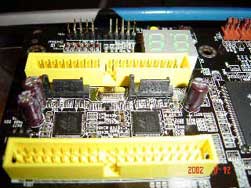 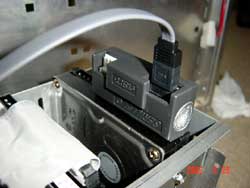
Serial / Parallel RAID (left) and Serillel adapter (right).
This IT7 MAX 2 Version 2 test report compared the hard disk performance when running the HHD from these different controllers and came to a surprising results: using the adapter gave a solid performance boost, despite the fact that the drive is still interfacing with the ATA HPT374 controller.
We tried to replicate the results and could indeed do so. However, we considered it at strange that the 845PE controller is so much behind in performance. We then realize that we were running the Winbench 99 benchmarks without having the Intel Application Accelerator installed. Repeating the WinBench 99 HDD Disk Mark tests with the IAA installed gave a completely different picture. Both scores gained significantly. When running the WB 99 Business Disk Mark from the 845PE the score is still lower than when using the HPT 374 controller, but this is probably more a test software issue than a 845PE problem. Based on our results we strongly recommend installing the Intel Application Accelerator or at least checking the impact on games and applications before deciding to drop it.
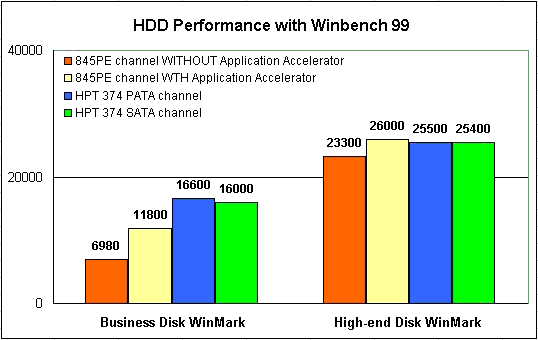
To sum our performance comparison up: The 845PE based ITI 7 MAX 2 Version provides around 40 MB/sec better bandwidth, this is just 2% more than the 845E based Version 1. Gaming benchmarks with Version 2 were slightly better and productivity benchmarks were identical between both versions. The observed differences are minor. The user will not notice them. In addition to adding official DDR 333 support Intel has obviously tweaked the 845E a little more. We can assume that more was not possible because the 845E chipset is already well performing and stable. Bottom line: the performance of both IT7 MAX 2 versions is almost identical with a very slight advantage for Version 2.
IT7 MAX 2 Version 2 Overclocking:
Already the original version of the IT7 was a strong overclocker and became the board of choice for many hardcore overclockers. Overclocking has even become a little easier with Version 2. As Version 2 is officially supporting DDR 333 it is now possible to set the FSB:RAM ratio to 3:4 AND 4:5. Previous IT7 versions allowed only the 3:4 ratio. Why is this important? Pentium 4 with lower multipliers like the 2.26 and 2.4 “B”, need rather high-front-side bus frequencies to exploit their full frequency potential. A 2.26 “B” for example is leveling out at around 17 x 180 MHz = 3060 MHz. In that case the memory frequency would be at 240 MHz when the FSB: RAM is set to 3:4. But 240 MHz is too much to handle for most memory modules, even when advertised as DDR 400 or higher. The alternative is then either to reduce the FSB frequency or to run the FSB and RAM synchronous at 1:1. Version 2 is more flexible here. The added 4:5 ratio allows exploiting the CPU headroom with a high memory frequency: a 4:5 ratio puts the memory “only” to a more sustainable frequency of 225 MHz.
The only other BIOS feature that has been changed can be found in “Advanced Chipset Features”. The “Enhanced DRAM Performance” in Version 1 has been replaced with “Differential Current” in Version 2. The later has more options than the previous “Enhanced DRAM Performance”, which could be only enabled or disabled. But as before with “Enhanced DRAM Performance” we failed to see any impact with “Differential Current” whatever setting we tried. Another nice touch and a safety measure for extreme overclocking already Version 1 was sporting is the “CPU Thermal Throttling” feature. It allows the user to decide how much how wants the CPU to throttle down when the thermal protection threshold has been reached: The options are 12.5% to 87.5%.
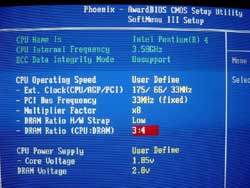 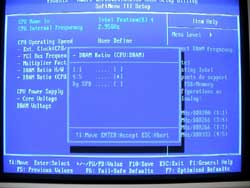
Version 1 BIOS (left) and Version 2 (right).
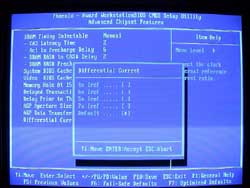 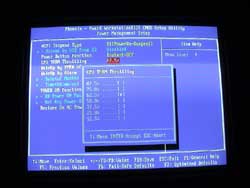
2 more shots of the Version 2's BIOS.
Other overclocking and tweaking relevant BIOS features remain unchanged namely the voltage options for the CPU (up to 1.725 volt) and the voltage options for the memory (up to 2.8 volt). Like our previous Version 1, our Version 2 test sample was very slightly undervolting. ABIT has found an elegant way to keep the memory voltage settings within “official” boundaries and provide the desired higher voltage for hardcore overclocking at the same time. The BIOS offers “only” up to 2.8 volt. This is 0.3 above default. Experience shows that this is not enough to fully exploit the potential of many memory modules. Many enthusiasts don’t worry running their memory at the highest possible voltage at least for a short period time to see how far they can take their system. The IT7 (all versions) BIOS has additional DIMM voltage options with up to 3.2 volt present, but hidden. It’s relatively easy to make the hidden options visible and selectable by using the well-known “modbin” BIOS modification utility. We have modified the latest IT7 Version 2 BIOS so that the hidden voltage options up to 3.2 volt can be selected. It can be downloaded here. Flashing and using a non-authorized BIOS is of course the user’s sole risk. A higher CPU voltage (up to 1.85 volt) can be achieved by wiring certain pins on the CPU.
We achieved air cooled and phase-changed cooled with a Vapochill cooling system slightly higher (20 MHz) CPU frequencies than with our IT7 Version 1. Air-cooled and with the additional voltage our 2.40 “B” went up to 2.960 MHz and made it phase-change cooled with our Vapochill to 3.340 MHz. At both frequencies it was possible to run “Prime 95” for around 1 hour. The slightly better results with Version 2 could be within the usual fluctuations between hardware samples - another explanation could be that the improved CPU power supply is providing for a slight better overclocking potential. In any case: the IT7 is good for extreme overclocking.
ABIT’s BIOS based SOFTMENU overclocking utility is not new anymore but overclocking friendly as ever and “resistant” against foolish overclocking attempts. It comes with a build-in routine that tries 4 or 5 times to start the system with certain BIOS settings, if this is not successful, means the system cannot boot because the settings are too aggressive for the CPU or the memory, it resets to defaults. Not a single time was it necessary to clear the CMOS to regain access to the BIOS after certain settings like the CAS latency and FSB had been set too high. We tried our best, but the BIOS resisted to become stuffed. Whatever extreme values we tried, the BIOS reset, after 3 or 4 unsuccessful attempts, to 100 FSB and default SPD settings for the memory and successfully rebooted. Very handy!
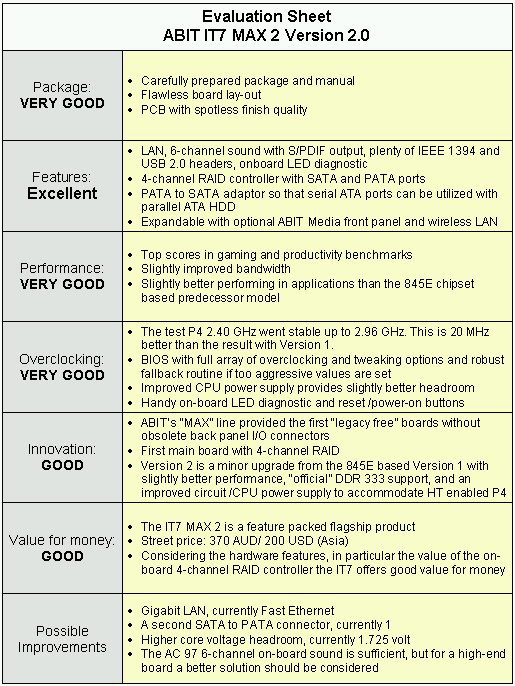
Conclusions:
A few weeks ago we called the 845E-based IT7 MAX 2 Version 1 the “best platform for Pentium 4 overclocking”. The succeeding Version 2.0 keeps all the good things and puts a few subtle changes and improvements on top of them. We don’t see much reason for Version 1 owners to change to Version 2.0. But anybody else considering an upgrade from an older mainboard should regard the 845PE based IT7 MAX 2 Version 2 as a top choice. An already very good product has become even better.
|
|
Advertisement:
All original content copyright James Rolfe.
All rights reserved. No reproduction allowed without written permission.
Interested in advertising on OCAU? Contact us for info.
|

|


